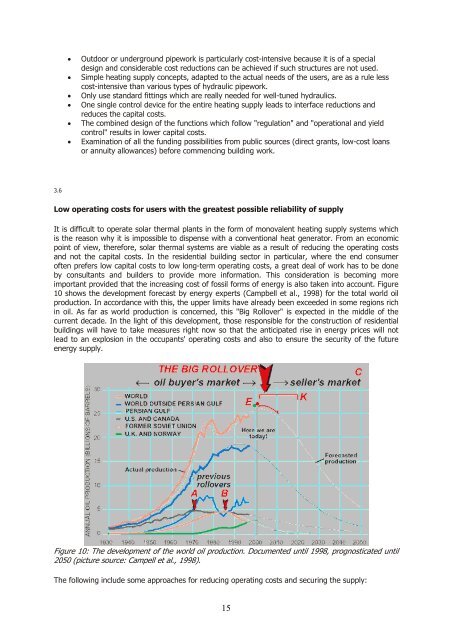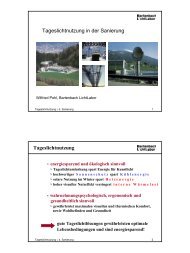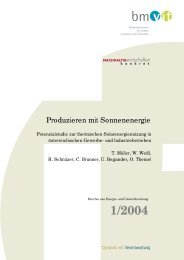Solar-supported heating networks in multi-storey residential buildings
Solar-supported heating networks in multi-storey residential buildings
Solar-supported heating networks in multi-storey residential buildings
Create successful ePaper yourself
Turn your PDF publications into a flip-book with our unique Google optimized e-Paper software.
3.6<br />
• Outdoor or underground pipework is particularly cost-<strong>in</strong>tensive because it is of a special<br />
design and considerable cost reductions can be achieved if such structures are not used.<br />
• Simple <strong>heat<strong>in</strong>g</strong> supply concepts, adapted to the actual needs of the users, are as a rule less<br />
cost-<strong>in</strong>tensive than various types of hydraulic pipework.<br />
• Only use standard fitt<strong>in</strong>gs which are really needed for well-tuned hydraulics.<br />
• One s<strong>in</strong>gle control device for the entire <strong>heat<strong>in</strong>g</strong> supply leads to <strong>in</strong>terface reductions and<br />
reduces the capital costs.<br />
• The comb<strong>in</strong>ed design of the functions which follow "regulation" and "operational and yield<br />
control" results <strong>in</strong> lower capital costs.<br />
• Exam<strong>in</strong>ation of all the fund<strong>in</strong>g possibilities from public sources (direct grants, low-cost loans<br />
or annuity allowances) before commenc<strong>in</strong>g build<strong>in</strong>g work.<br />
Low operat<strong>in</strong>g costs for users with the greatest possible reliability of supply<br />
It is difficult to operate solar thermal plants <strong>in</strong> the form of monovalent <strong>heat<strong>in</strong>g</strong> supply systems which<br />
is the reason why it is impossible to dispense with a conventional heat generator. From an economic<br />
po<strong>in</strong>t of view, therefore, solar thermal systems are viable as a result of reduc<strong>in</strong>g the operat<strong>in</strong>g costs<br />
and not the capital costs. In the <strong>residential</strong> build<strong>in</strong>g sector <strong>in</strong> particular, where the end consumer<br />
often prefers low capital costs to low long-term operat<strong>in</strong>g costs, a great deal of work has to be done<br />
by consultants and builders to provide more <strong>in</strong>formation. This consideration is becom<strong>in</strong>g more<br />
important provided that the <strong>in</strong>creas<strong>in</strong>g cost of fossil forms of energy is also taken <strong>in</strong>to account. Figure<br />
10 shows the development forecast by energy experts (Campbell et al., 1998) for the total world oil<br />
production. In accordance with this, the upper limits have already been exceeded <strong>in</strong> some regions rich<br />
<strong>in</strong> oil. As far as world production is concerned, this "Big Rollover" is expected <strong>in</strong> the middle of the<br />
current decade. In the light of this development, those responsible for the construction of <strong>residential</strong><br />
build<strong>in</strong>gs will have to take measures right now so that the anticipated rise <strong>in</strong> energy prices will not<br />
lead to an explosion <strong>in</strong> the occupants' operat<strong>in</strong>g costs and also to ensure the security of the future<br />
energy supply.<br />
Figure 10: The development of the world oil production. Documented until 1998, prognosticated until<br />
2050 (picture source: Campell et al., 1998).<br />
The follow<strong>in</strong>g <strong>in</strong>clude some approaches for reduc<strong>in</strong>g operat<strong>in</strong>g costs and secur<strong>in</strong>g the supply:<br />
15














